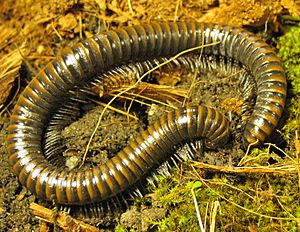Paeromopus angusticeps facts for kids
Quick facts for kids Paeromopus angusticeps |
|
|---|---|
 |
|
| Scientific classification | |
| Kingdom: | |
| Phylum: | |
| Class: | |
| Order: |
Julida
|
| Family: | |
| Genus: | |
| Species: |
P. angusticeps
|
| Binomial name | |
| Paeromopus angusticeps (Wood, 1864)
|
|
| Subspecies | |
|
P. angusticeps angusticeps |
|
| Synonyms | |
|
Spirobolus angusticeps Wood, 1864 |
|
The California Giant Millipede, also known as Paeromopus angusticeps, is a fascinating creature. It's a type of millipede that lives only in the U.S. state of California. This millipede has the biggest home range of all four Paeromopus species.
You can find it across much of Northern California. Its range stretches from Monterey County on the central coast. It goes north along the Coast Ranges to Humboldt County. Then, it moves down along the Cascades and Sierra Nevada mountains in eastern California. However, you won't usually find P. angusticeps in California's Central Valley.
What Does P. angusticeps Look Like?
Adult California Giant Millipedes are quite large. They can have up to 80 body segments. Imagine a long, segmented body! These millipedes measure from 100 to 150 millimeters (about 4 to 6 inches) long. They are also about 5 to 7 millimeters (0.2 to 0.3 inches) wide.
Their bodies often have a cool color pattern. They usually have alternating bands of brown on a black or blue-black background. Sometimes, these bands are hard to see. Like other millipedes in the Paeromopodidae family, their outer shell has tiny parallel grooves. These are called striations. Each eye of the millipede is made up of about 30 ocelli. Ocelli are simple eyes, and they are arranged in a patch on each side of the millipede's head.
Subspecies: Different Types of P. angusticeps
The populations of Paeromopus angusticeps are divided into two main groups. These groups are called subspecies. They are named P. a. angusticeps and P. a. buttensis. Scientists tell them apart by small differences in their gonopods. Gonopods are special body parts that male millipedes use for reproduction.
The P. a. angusticeps subspecies lives in the San Francisco and Monterey Bay area. This includes places from Marin to Monterey County. The other subspecies, P. a. buttensis, is found over a wider area. It lives in the northern and eastern parts of the millipede's range.
Before the 1990s, scientists thought these two groups were completely different species. But then, they found populations in Solano and Sonoma counties that had features of both groups. These are called intergrade populations. This discovery showed that the two groups were actually subspecies of the same millipede.

